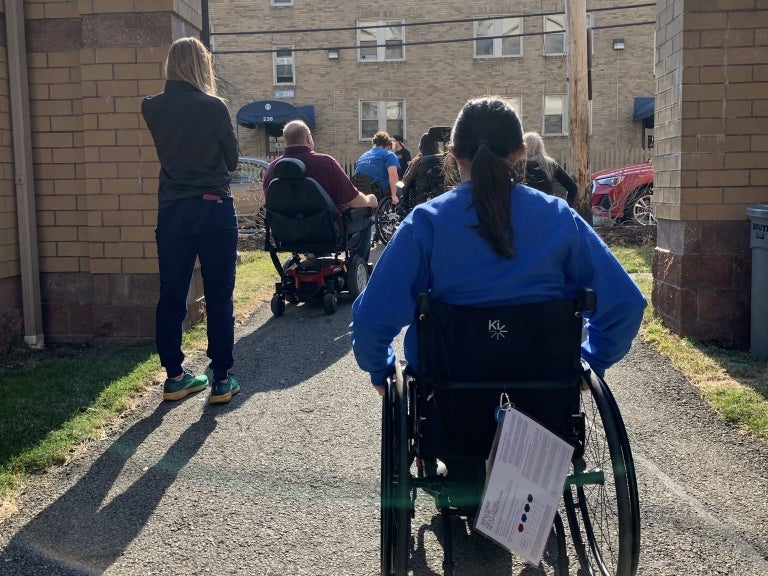
The University of Pittsburgh School of Health and Rehabilitation Sciences online Master of Rehabilitation Technology program combines online coursework with in-person instruction to offer students a balanced experience. And balance was the name of the game at the most recent Deep Dive! My fellow classmates and I traveled to Pitt from across the country to participate in the Deep Dive, which happens once a semester and allows students to take what they’ve learned in the MRT program and apply it in a hands-on way. I’m confident it’ll be your favorite part of the semester! This term, we are taking a Clinical Applications of Seating & Mobility course led by Assistant Professor Rachel Hibbs and Clinical Assistant Professor Rebecca Russell, where we’ve been learning all about manual and power wheelchairs. At the Deep Dive we explored the topic even further.
We started off learning about how the configuration and fit of a manual wheelchair impacts function. It’s important that a wheelchair fits the user like a glove. We each took turns sitting in different manual wheelchairs in the clinic and evaluated how well they fit us. The first wheelchair I sat in had a wheel axle that was too far behind me, and the seat was too wide for me. I had a difficult time reaching the wheels to propel this wheelchair and felt strain in my shoulders. I was quick to switch to another wheelchair. In the next wheelchair, while I was able to reach the wheels, the backrest was too tall for me, so my movement to propel the wheelchair was restricted. I knew there had to be a better chair for me, so I switched to a third one. The next wheelchair I found made a big difference. The seat was just as wide as my hips and the wheel axle was placed further forward. The backrest was shorter, and my feet reached the footplate. I was able to propel the wheelchair so easily and felt way more comfortable. Now I have felt and seen firsthand how the setup of a wheelchair impacts function. I have a better understanding of what to consider when I spec out a wheelchair for my future clients.
My favorite part of the training was learning various wheelchair skills. The most fundamental skill was learning how to pop a wheelie. It was a little scary at first to lean back and get the front casters off the floor. Once I found that sweet spot that allowed me to balance in the wheelie position, I felt a lot more comfortable. Next, we learned how the wheelie is used to navigate common obstacles in our environment. We practiced using a wheelie to overcome simulated door thresholds, curbs and potholes. I learned that it’s all in the timing!
Our final challenge was taking the manual wheelchairs outside and navigating the streets of Pittsburgh. I quickly learned that propelling uphill can be really tiring. I learned how a wheelie is essential to navigating all the potholes and cracks in the sidewalks. A few times I even got stuck because I forgot to pop a wheelie. By the end of the session, my shoulders were sore and I was tired, as I wasn’t used to propelling and using those muscles.
I now appreciate how much energy goes into propelling a manual wheelchair. I also recognize how the built environment impacts access. If a manual wheelchair user doesn’t know how or can’t do a wheelie, they may be restricted from accessing places without curb cuts or get stuck in potholes. Now I recognize the importance of wheelchair skills and will be able to teach the basics to my future clients. Most importantly, I have a better understanding of what it’s like to use a manual wheelchair and I’ll be able to better relate to my future clients.
--

Written by: Meghan Mulloy (MRT ‘22)
----
Updated April 23, 2024
